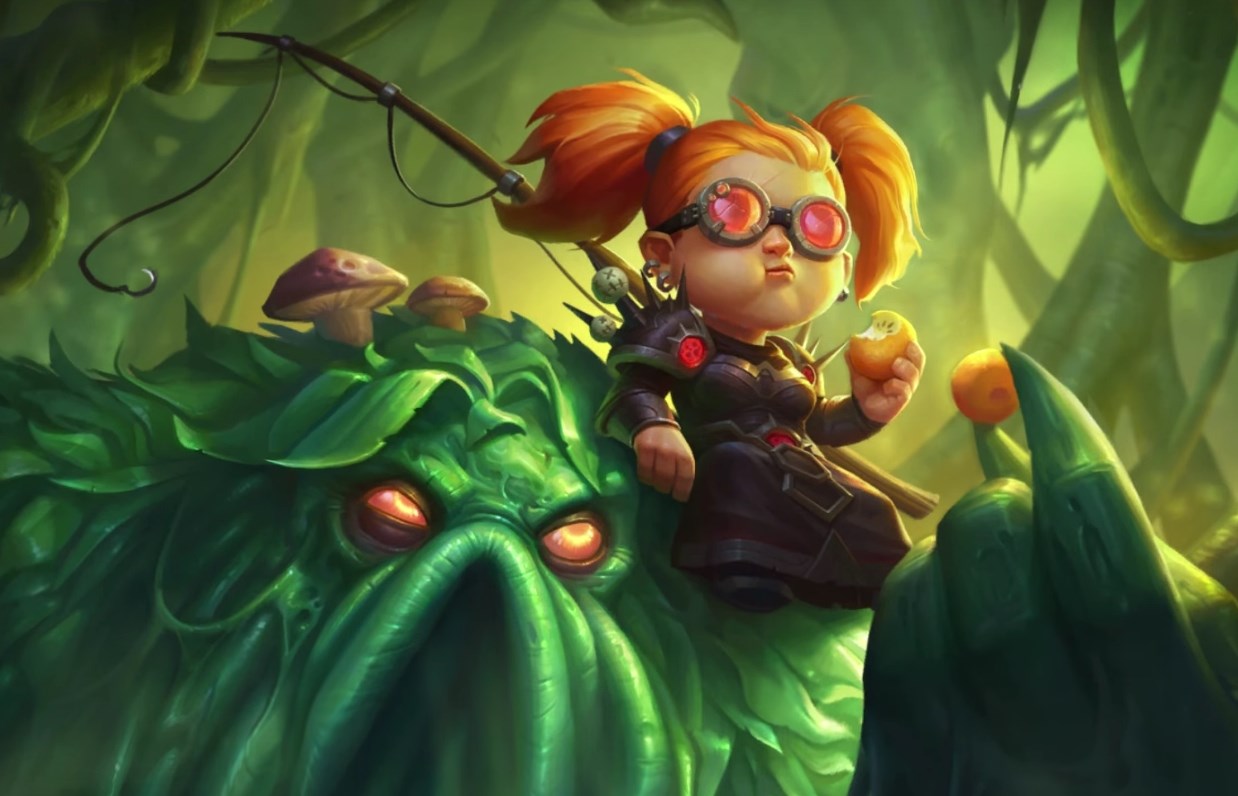PC Gamer's got your back
We originally reviewed Hearthstone in 2014 after it released in open beta. Blizzard's CCG has changed significantly since then, so much so that we decided to review it again. Our original review can still be found here. For more about why we've chosen to re-review certain games, head here.
What is it? A free-to-play competitive card game that originally launched in 2014.
Expect to pay: Free-to-play; new cards can be earned through playing, or purchased in packs
Developer: Blizzard Entertainment
Publisher: Blizzard Entertainment
Reviewed on: Radeon HD 7850, Intel i5-3570k 8GB RAM
Multiplayer: Online 1v1 in ranked and casual modes, or against a friend.
Link: Official site
Buy: Download via Battle.net
It’s tempting to start this review with some anecdote about a time I've had a game decided by Hearthstone's notorious RNG. It would be easy for me to recall three Arcane Missiles all improbably hitting my precious face, which I’d thought was safe behind a full board of possible targets. Or perhaps I could pick one of the occasions I pulled off an unlikely win from behind, drawing the one card in my deck that could pull me out of an otherwise hopeless hole. I could also talk about the thrill of finding the two best Legendaries in a new set from my first five packs, or how I once drafted the perfect deck in Arena only to lose three times in a row to obscenely unlucky draws. But I don’t want to do that, because zeroing in on Hearthstone’s most spectacular moments obscures what makes the game special.
For me, it’s always been about the big picture. The satisfaction Hearthstone gives me isn’t rooted in watching egregiously unlikely outcomes happen—though obviously that does appeal—but comes from seeing such scenarios unfold hundred of times until the variance evens out. When that happens, you start to see the most popular meta matchups as probability trees that stretch out in all directions. It’s easy to talk about RNG in Hearthstone as something that’s fundamentally disruptive, when in reality it’s just another element to factor into your planning. To really play Hearthstone is to get to the point where your plays are guided by the chance inherent in the game, rather than thwarted by it.
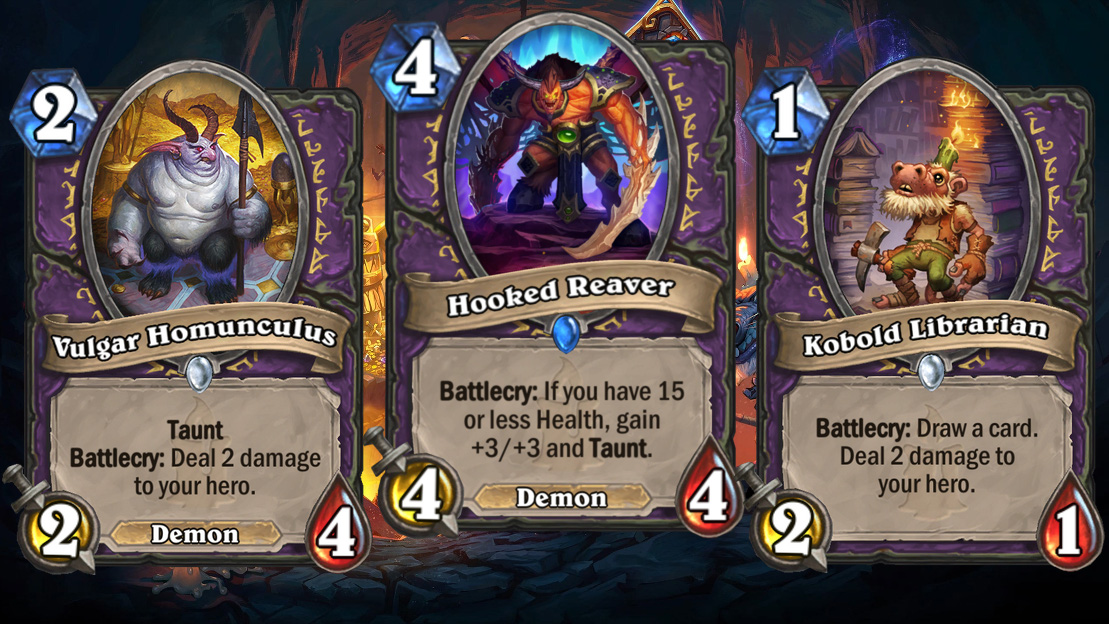
Well met!
Let’s take a step back from the high level stuff for a second. Hearthstone is a strategy game developed by Blizzard and released in 2014. It wasn’t the first collectible card game (CCG) adapted for the PC, but it was the one to make the genre explode in the digital space. These days there are many imitators, all looking to carve off some of the same success. The most notable include Gwent, The Elder Scrolls: Legends, and Valve’s soon-to-be-released Artifact. All that means Hearthstone isn’t quite the monolith it once was, but make no mistake: it’s still the king of digital CCGs. And for good reason. Hearthstone's major success is in keeping the core mechanics simple enough for new players to not immediately feel out of their depth, while leaving more than enough complexity to keep you hooked for the long term.
The Mana system epitomises this elegant approach: eschewing the complicated arrangements employed by paper CCGs like Magic: The Gathering, Hearthstone instead simply awards one mana crystal to each player each turn. The choice between classes is equally streamlined. There are nine to choose from, each styled after an equivalent from World of Warcraft. Hearthstone does a good job of giving each of its classes a distinct flavour, which carries over to their play styles and deckbuilding specialisations. Warlock, for example, relies on making sacrifices in exchange for more powerful cards. Mage has a diverse and powerful array of spells. Priest is really good at stealing your stuff. When you’re just starting out with an intimidating new multiplayer game, these clear identities go a long way to helping you figure out what kind of deck you want to play.
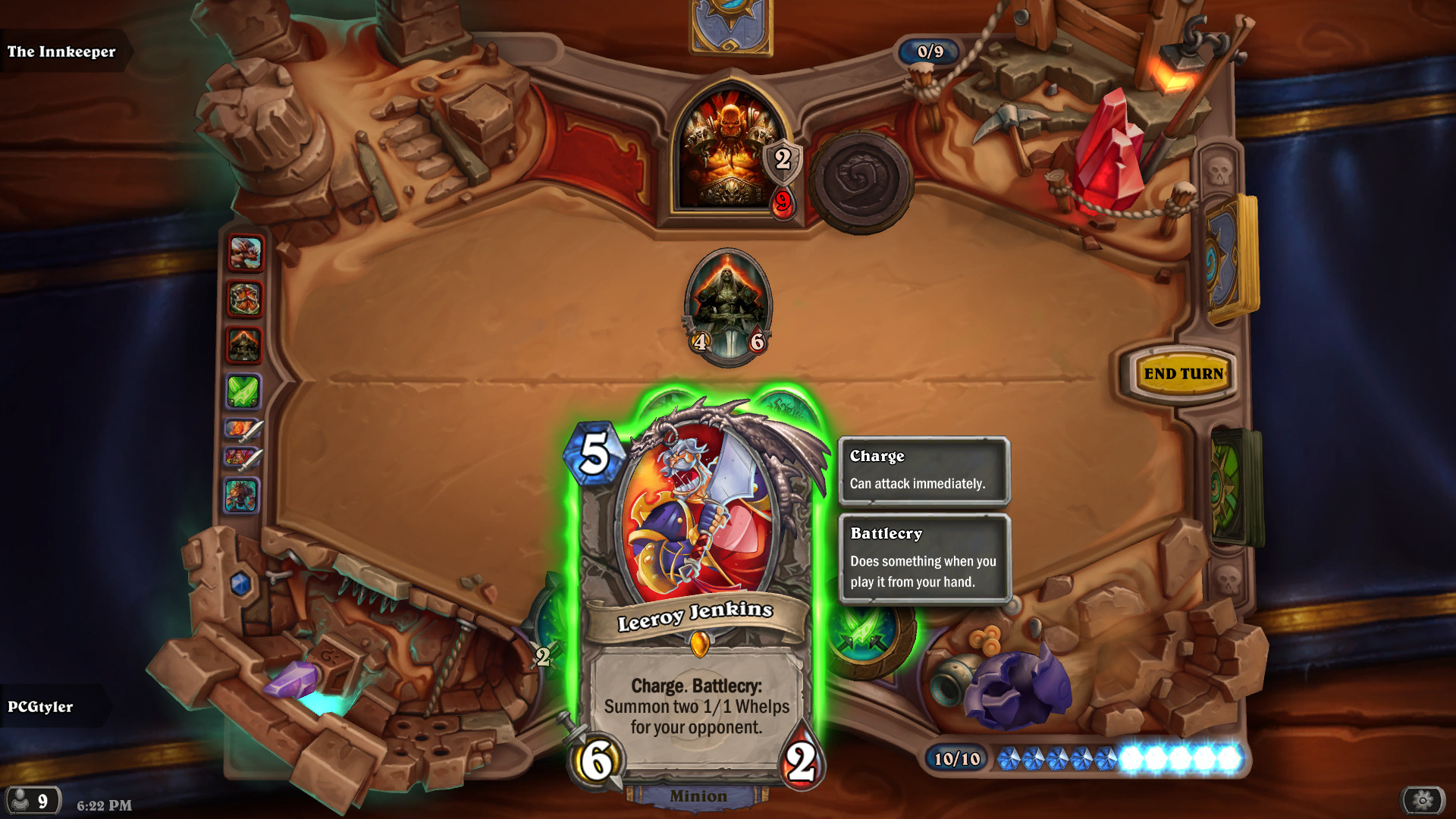
Every interaction, from the flashy Legendary entrance effects all the way down to the card-draw animations, drips with polish and finesse.
New players find themselves funnelled into the game by way of a tutorial, which has remained largely unchanged since release, and consists of six (easy) challenges versus AI opponents. Whether this is particularly useful or not depends on the level of CCG experience the player has. I found it instructive, despite having played quite a lot of Magic: The Gathering beforehand, but I know some would rather get into the main game and not deal with it.
Probably the main reason the tutorial didn’t bore me to death was the sheer novelty of seeing a how beautifully the cards and their interactions are rendered. Spells fizz with colourful effects that make them all the more satisfying as you launch them at your opponent’s face. The minions—those are the creatures you play onto the board—all have characterful, often jaunty, lines of dialogue which they blurt out when you summon them, when they attack and when they die. When you dome the enemy player with a giant minion the game board shakes violently. Most people envision card games as relatively static, with the fun stemming from the rules rather than the presentation. Hearthstone is not like that. Every interaction, from the flashy Legendary entrance effects all the way down to the card-draw animations, drips with polish and finesse.
That sense of fun and novelty even extends to the game board itself, around which there are numerous oddities and trinkets—players call them ‘clickies’—to interact with. It's a nice touch. Waiting for your opponent to take a long turn can often be pretty dull, so it's nice to be able to allay that boredom by farming veggies or prodding a volcano.
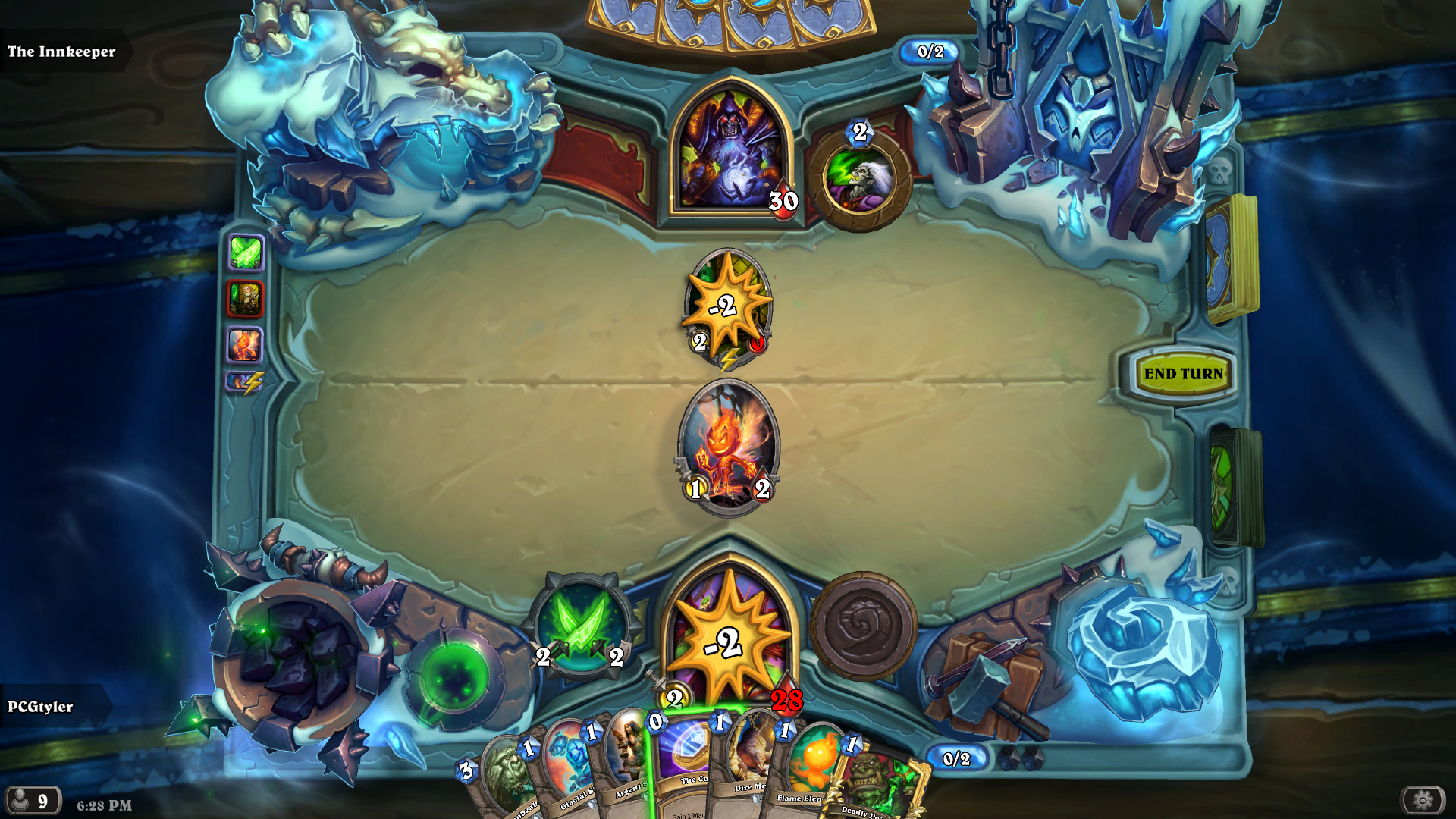
Free-to-play, by the way
So the production values are stellar, but let’s address the elephant in the room: How you pay for this stuff. Yes, you can buy card packs in Hearthstone. Yes, if you want access to all the best competitive decks, the best way to do that is to spend money. Taking a free-to-play route is definitely possible—you can earn around 150 gold a day from your daily quests, plus extra from grinding Ladder and Arena (more on those later)—but you’re paying with time, and it’s a substantial grind. And while there has been an increase in handouts from Blizzard—like free packs with each new set, and card awards at the end of every season—these do little to offset the effect of a content release schedule that has grown steadily faster over the years. This is all deliberate, of course: the Hearthstone business model is reliant on people wanting to keep their collection up-to-date with the release of each new set—if it was easy to do this free-to-play, then no one would ever buy packs.
The main thing that the free-to-play people will miss out on is variety. High ranks are certainly attainable on a budget, given that in pretty much every metagame Hearthstone’s ever seen there’s been a budget deck that could compete with the big boys. You’ll be able to build it with some grinding and judicious use of the crafting system, but how long until you get bored of playing that one deck? It can certainly also get frustrating getting matched against decks full of shiny Legendaries when your cards all look like something a WoW player might have to kill ten of for a quest.
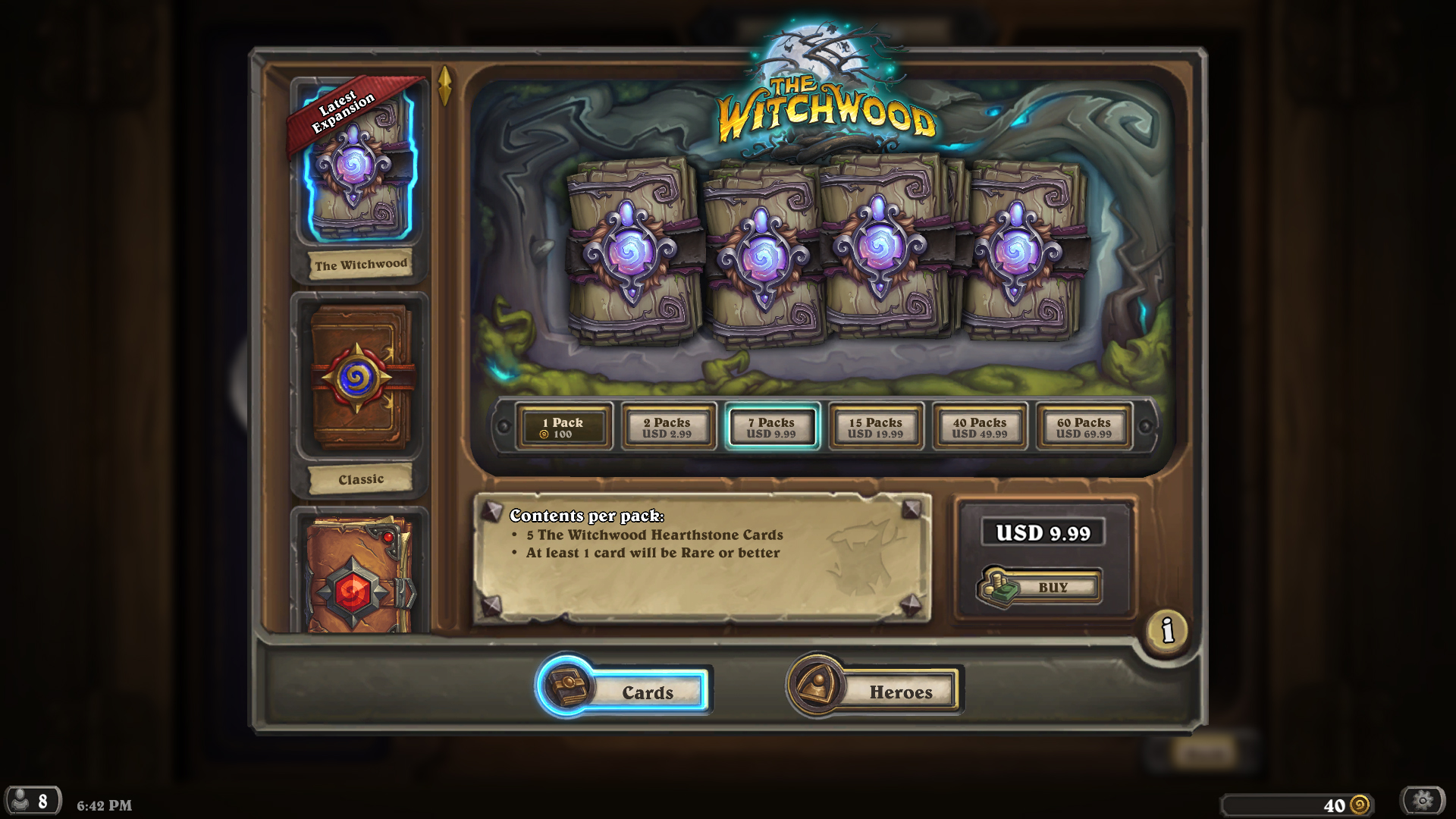
I’d also challenge the notion that card games have to adopt this exact business model. The precedent that paper CCGs have set need not apply in the digital world. There are some clear advantages, though: namely allowing the bulk of players to have plenty of fun without spending any money at all, something that would not be possible if they weren’t propped up by whales at the other end of the spectrum. Still, plenty of those players will end up feeling alienated by perceived financial inequalities between them and their opponents. As with much of Hearthstone, it’s a tricky thing to balance perfectly.
I'd personally much prefer the option of paying a set fee to buy the game and have all the cards unlocked from a set. This is the model that Artifact, Valve’s upcoming CCG, promises to follow. And honestly, I’m excited by it. Hearthstone’s freemium model does have advantages, it’s just that most of the advantages will be conferred on the players at the more casual end of the spectrum. More competitive players, which I’d include myself among, don’t benefit as much.

Playing your cards right
The key to Hearthstone’s enduring success is that, regardless of what it’s detractors might say, it remains a deep and rewarding strategy game. It’s ability to refresh itself with new Keywords, and in the case of Quests and Death Knights, even entirely new types of cards, is another huge reason it stays fun, despite some obnoxious metas. I’ve played for four years, and still don’t feel close to mastering all the nuances. A big part of it is the deckbuilding, which provides an almost infinite array of possibilities across the nine classes and 1,500+ cards. Obviously, the vast majority of those possibilities won’t make for a strong competitive deck—although, depending on what a person’s idea of fun is, mileages vary on this—but it still takes a really long time for even the best players to figure out the most refined decks after the release of a new expansion. Quite often entirely new archetypes are discovered just weeks before the release of the next expansion, as former game director Ben Brode pointed out in his last PC Gamer interview.
Once in-game, the systems are also deeper than they’re often given credit for. It’s unavoidable that a lot of these systems and interactions are common to most CCGs: using your resources efficiently, calculating the odds of a play being the right one, and making reads on your opponent’s hand are all elements that fit in this category. If you’re a complete CCG newbie, then these will take a lot of learning. The importance of playing your cards to fit your mana curve, for example, is a lesson that emerges over the course of the first few games. Baiting out your opponent’s removal spells before playing your game-winning minion is another. And so on.
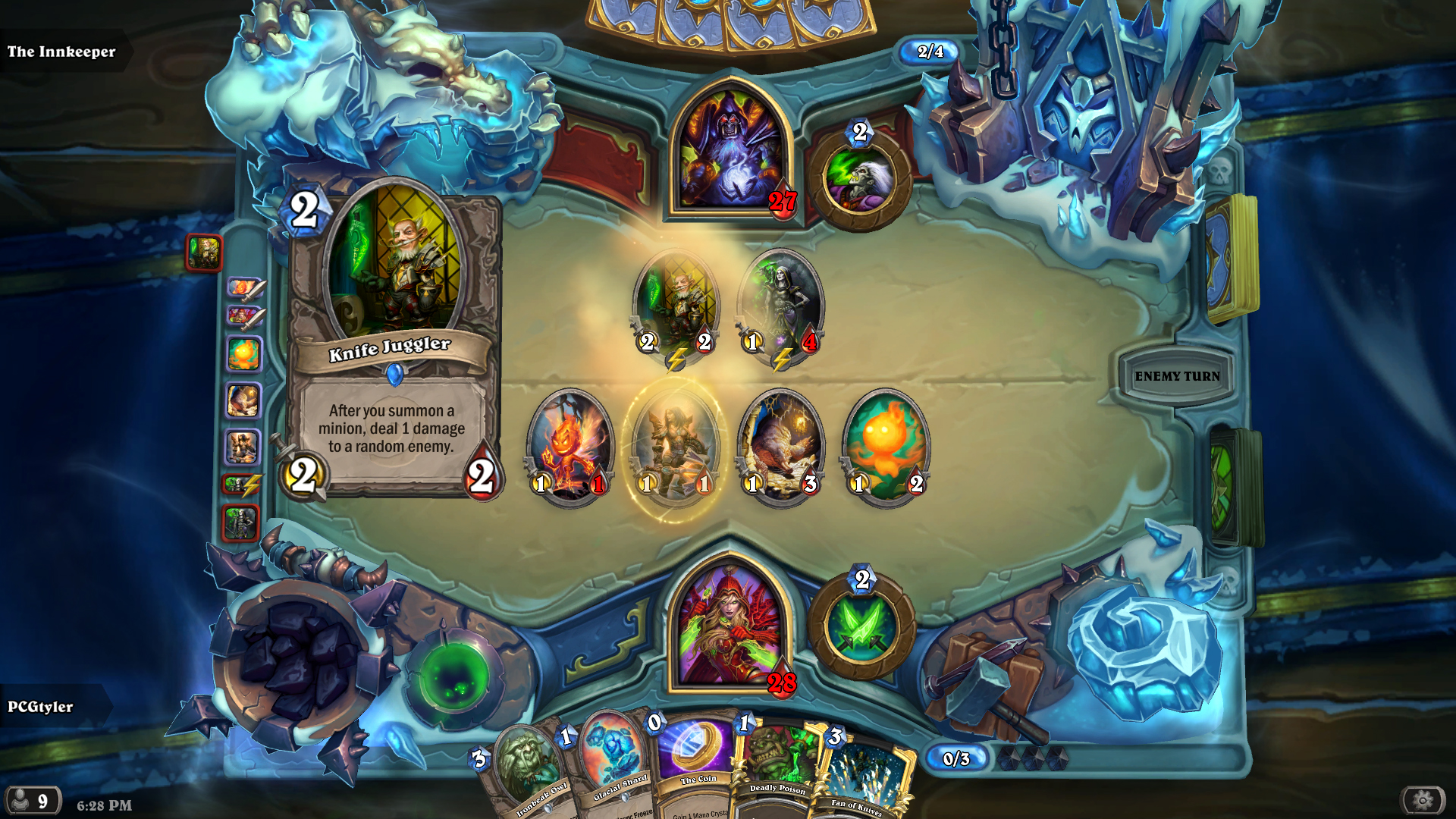
In the process of trying to read too deeply into what his card was, I had managed to mind-game myself out of a win.
But there are also plenty of quirks unique to Hearthstone. The emphasis on minion combat is a vital point of difference. You’ll quickly figure out that winning games is more about controlling the board than it is lowering your opponent’s life total, and maintaining supremacy over the board involves a lot of bashing your minions into stuff. This emphasis on board dominance doesn't always feel like such a great thing. There are times when your opponent simply has the most efficient minions for their mana each turn, while you're left pondering your hand full of three-cost cards on your four-mana turn. It's the kind of situation that leads to the game being dubbed 'Curvestone': where you feel like the decisions you make are dwarfed by the importance of a good deck and a good draw.
Hearthstone's also distinguishes itself from its paper counterparts with a host of card effects that could only ever be possible in a videogame. The one that stands out is the creation of cards out of thin air with spells like Priest's Thoughtsteal, which copies cards from the opponent's deck and puts them in your hand, or Mage's Cabalist's Tome, which adds three random Mage spells to your hand. This adds another vicious level of mind games to proceedings. It often means that in addition to playing around all the cards that should be in your opponent's deck, you have to play around cards that shouldn't be, too.
Etched into my memory still is a traumatic Mage vs Rogue game where my opponent, through the use of various Rogue minions and spells that steal cards from the opponent's class, played a Mage 'secret'. Secrets are spells that, when played appear as question marks under the player's portrait, and you have no idea what they are until you fulfil the condition that triggers them. Anyway, during this game I managed to convince myself that this secret must be Ice Block, a card that stops the player from dying the first time they take lethal damage. I consequently passed up several opportunities to kill him, thinking that the Ice Block would prevent it and I would end up losing. As the game ebbed and flowed, he eventually got into an advantageous position where I didn't even have the resources to trigger an Ice Block. I lost. After the game, I asked him what the Secret was. It wasn't Ice Block, it was Spellbender. In the process of trying to read too deeply into what his card was, I had managed to mind-game myself out of a win.

Hearthstone asks you to make big decisions on a constant basis. So many that you begin to develop your own internal logic for approaching turns, which over the course of hundreds of games becomes your own personal playstyle. Everyone does this, and so everyone finds that some decks suit their playstyle better than others. For the players who discover they don't particularly like trading much, instead preferring to rush down their enemy with Charge minions, Aggro decks appeal. And for those who'd rather fortify their life total while removing everything their opponent plays, control decks are a better match. And don't even get me started on Combo deck players, who are never happier than when they're pulling off a degenerate one-turn-kill combo. This runs all the way to the top of the game, with even pro players often deviating from correct 'meta' choices to play the deck they are most comfortable with. Hearthstone provides plenty of options to help you find the style that suits you best. That's a very good thing.
Different strokes
Hearthstone being Hearthstone the underdog may still have a slugger’s chance, particularly if they get a favorable matchup or a nut draw.
Ladder is Hearthstone's constructed mode, an ELO-type system that allows you to climb the ranks with ‘constructed’ decks of your own making. You climb by gaining stars, which you're awarded one of each time you win a game. Gain five stars and you’ll move up to the next rank. Usually a star is taken away when you lose a game, but these days there are several rank ‘floors’ that you can never fall below. There also win-streaks, which boost your progress up the ranks when you win three in a row or more. For the most part, the matchmaking does a good job of making sure your opponents are of a similar level to you. There are occasional anomalies, however, as even the very best players will eventually find themselves at the lower ranks if they don’t play for long enough. This occasionally results in some unfortunate mismatches, but Hearthstone being Hearthstone the underdog may still have a slugger’s chance, particularly if they get a favorable matchup or a nut draw.
Arena is a little different. Unlike Ladder, it has a cost of entry: either 150 gold or actual cash. It’s akin to the Limited format in Magic: The Gathering, so you draft your deck by picking from cards offered to you three at a time, then face off against other players who’ve done the same. You play until you either lose three times or reach 12 wins, and at the end there’s a prize depending on how many wins you racked up. Arena tends to be attractive to new players, probably because of the absence of any kind of deck requirement. I also imagine its self-contained nature is less intimidating than ladder, which can often be scary to jump into when everyone seems to be playing brutally efficient decks they’ve copied from the the vast repository of ‘net decking’ sites.

Hearthstone also now features multiple single-player modes which weren’t present at launch, some of which you have to pay for. Monster Hunt and Dungeon Run are the simplest modes, pitting the player against a series of computer-controlled adversaries. These are both very fun, pairing a well-designed difficulty curve with a flavorful atmosphere. Both were added relatively recently, as part of the last two expansions, which made it seem all the more conspicuous that Hearthstone had gone so long without a compelling solo offering. That said, these AI battling side-activities are quickly exhausted, leading you inevitably back to multiplayer. And—yes—the temptation to spend money.
It’s easy to conclude that Hearthstone isn’t going to be toppled anytime soon. While it now has rivals, none of them have come close to denting Blizzard’s dominance. What’s also easily forgotten is that there are very good reasons for Hearthstone’s stranglehold on the digital CCG scene. Elder Scrolls: Legends is one of example of a game that came along and brought some very interesting mechanical innovations to the table, but failed to deliver when it came to flavor and visual design. That stuff’s important, and Hearthstone does it better than any other card game by a significant margin. Combine that polish with enough depth for most players and you have a game that remains even more of a compelling proposition four years after its release. So if you somehow haven’t tried it until now, this is a better time than any to jump in. Just don’t play Priest, otherwise we can’t be friends.
